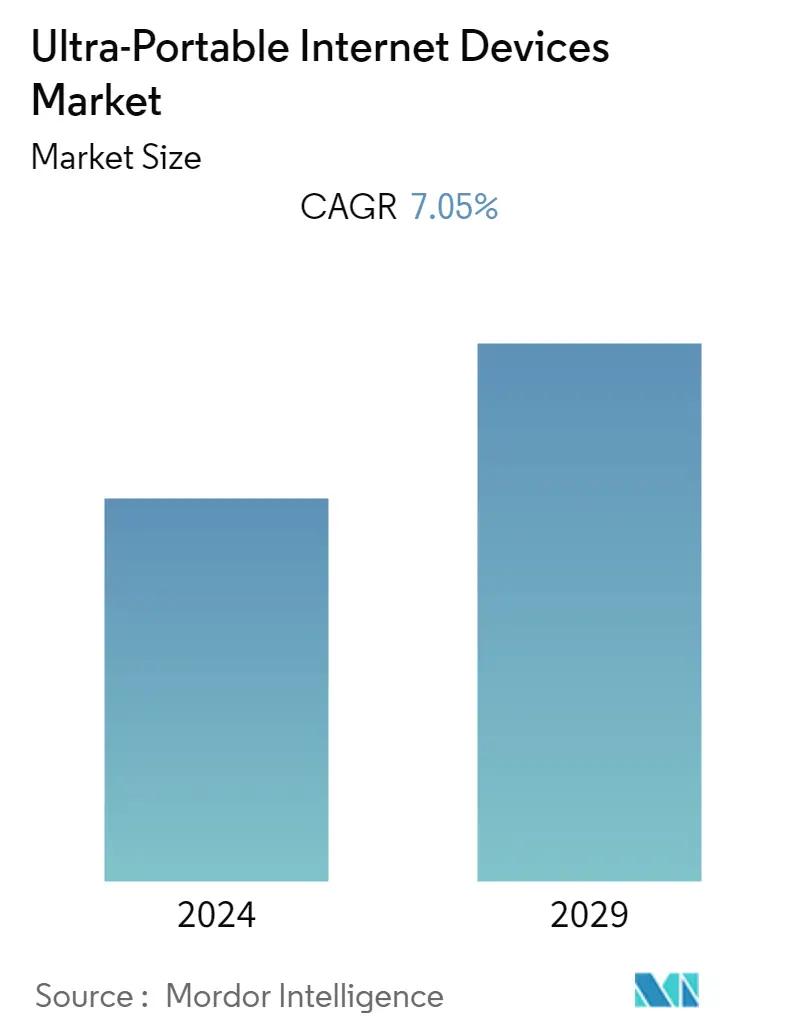Market Size of Ultra-Portable Internet Devices Industry

| Study Period | 2019 - 2029 |
| Base Year For Estimation | 2023 |
| CAGR | 7.05 % |
| Fastest Growing Market | Asia Pacific |
| Largest Market | North America |
| Market Concentration | Low |
Major Players
*Disclaimer: Major Players sorted in no particular order |
Need a report that reflects how COVID-19 has impacted this market and its growth?
Ultra Portable Internet Devices Market Analysis
The ultra-portable internet devices market is expected to register a CAGR of 7.05% over the forecasted period. With the growing mobility trend, an increasing number of end users are replacing traditional PCs and associated gadgets. The availability of low-cost solutions, combined with the desire for computers, entertainment, and communication devices, is likely to boost the market penetration of these gadgets.
- The ultra-portable internet device market is anticipated to grow with the growing adoption of IoT devices. The adoption of smart home devices has been aiding the development of portable internet devices. The growth in the sale of IoT and connected devices is driven by emerging applications and business models supported by falling device costs and standardization. According to Ericsson's mobility report, out of the projected 29 billion connected devices by 2022, 18 billion were expected to be related to IoT.
- The constantly changing criteria for better routers is one of the elements driving the demand for portable internet devices. Throughout the last decade, portable internet devices have grown steadily, keeping up with developments in standards set by the Institute of Electrical and Electronics Engineers. These specifications are continually updated to improve network throughput in terms of maximum speeds and transmission capacities. Ultra-portable mobile devices provide greater portability and access to cloud-based content. As a result, low-weight, advanced, consumer-friendly computer gadgets have emerged, boosting the market's growth.
- According to a survey conducted by the World Advertising Research Center (WARC) utilizing statistics from the mobile trade association GSMA, it is expected that over 1.3 billion people will access the internet via smartphone and PC by 2025. Furthermore, 69 million people are predicted to access the internet solely through a PC. According to WARC, approximately 2 billion individuals currently access the internet through smartphones, accounting for 51% of the global base of 3.9 mobile users. This is expected to hinder the market's growth.
- Severe macroeconomic vulnerabilities were exposed to the public in many countries due to the global financial crisis and the accompanying euro area crisis. The issues covered various macroeconomic imbalances unrelated to the public sector's excessive debt. House prices, loans, and wages all grew wildly in several nations. These internal imbalances frequently coexisted with escalating current account deficits, declining export performance, and continuous cost and pricing competitiveness declines. At the same time, policymakers did not create enough fiscal safety nets. In addition, a lack of structural changes left most of these economies with severe rigidities preventing efficient resource allocation. These will show a negative effect on the customer purchase power, affecting the market studied.
- Working from home has become standard these days. The speed of the shift to large-scale remote work has resulted in the use of personal devices, including mobile phones, laptops, tablets, and desktops. Employees are also observed using personal internet connections to access the corporate network. According to Eurostat, during the pandemic, a considerable increase was observed in the proportion of employed people in Europe who could work from home, reaching 29.4%in France, 22.8% in Germany, 15.1% in Spain, and 13.6% in Italy.

